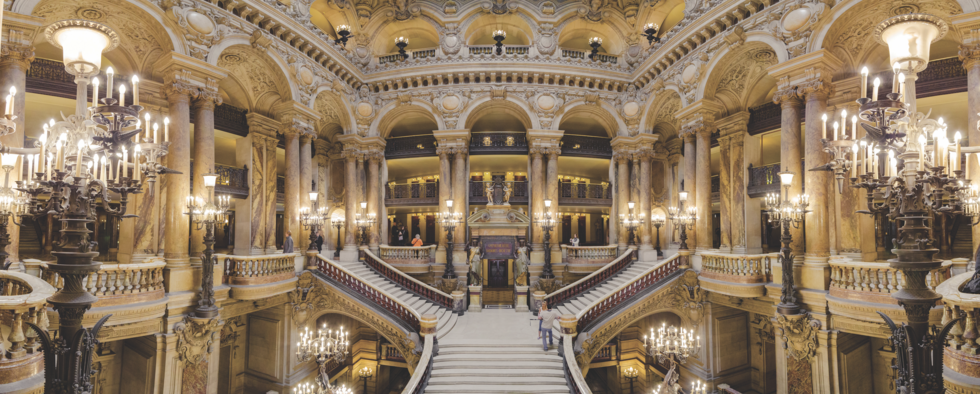Flamboyant, extravagant, and baroque, this splendid example of Second Empire architectural excess, built by architect Charles Garnier between 1862 and 1875, sits on the underground lake that inspired Gaston Leroux’s 1911 novel, The Phantom of the Opera. Corinthian columns, loggias, busts, and friezes cover the facade of the building, which is topped by a flattened gold dome. Seventy-three sculptors worked on the decoration, which includes portraits of composers, Greek gods, and symbolic representations of Music, Poetry, Drama, and Dance.
The interior is no less dramatic. The vast lobby, built in a spectrum of different colored marble, holds a spectacular double staircase that sweeps up to the different levels of the auditorium, as well as an array of glamorous antechambers, galleries, and ballrooms that make you wonder how the opera scenery could possibly compete. Mosaics, mirrors, gilt, and marble line these grand spaces, whose painted ceilings dance with fauns, gods, and nymphs. The largest room, the grand foyer, is drenched in gold leaf and hung with gigantic chandeliers, looking something like a real palace, which was, in fact, the effect Garnier was going for. The main event, of course, is the auditorium, which might seem a bit small, considering the size of the building. In fact, it holds not even 2,000 seats. The horseshoe shape of the seating area ensures that viewers see both the stage and each other—19th-century operagoers were equally concerned with what was on the stage and who was in the house. The beautiful ceiling was painted in 1964 with colorful images from various operas and ballets by Marc Chagall.
All of this (with the exception of the Chagall ceiling) sprang from the mind of a young, unknown architect named Charles Garnier, who won a competition launched when Napoleon III decided the time had come to build himself an opera house. Though the first stone was laid in 1862, work was held up by war, civil unrest, and a change in regime; the Palais Garnier was not inaugurated until 1875. Some contemporary critics found it a bit much (one called it “an overloaded sideboard”), but today it is generally acknowledged as a masterpiece of the architecture of the epoch.
You can visit the building on your own (for a fee), but with so much history and so many good stories, you might want to take advantage of the guided visits in English (15.50€ adults, 8.50€ children 9 and under; Wed, Sat, and Sun at 11:30am and 2:30pm; daily July–Aug and French school vacations 11:30am and 2:30pm). Or simply buy tickets to a show.






 About our rating system
About our rating system


